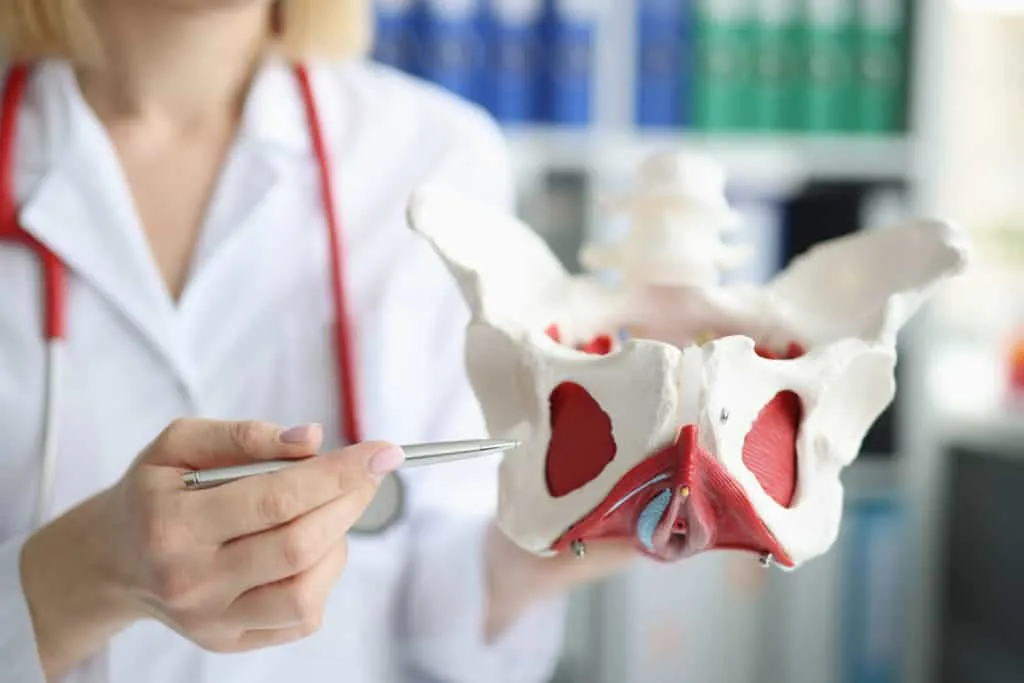Do you have an issue with weak or overly tight pelvic floor muscles?
Are you anxious about pelvic floor therapy and want to know more about it?
And are curious to know whether it hurts?
Pelvic floor therapy is a treatment method that uses a targeted form of physical therapy and myofascial release to recondition the pelvic floor muscles effectively and safely.
Pelvic floor therapy treatment improves the functioning and strength of weak pelvic floor muscles.
In addition, it helps to relieve pain and other symptoms like urinary incontinence or pelvic organ prolapse.
The “pelvic floor” is a hammock-shaped layer of connective tissues and muscle fibers that stretches from the front to the back of your body, from the sacrum to the pubic bone, and holds your bowel, bladder, uterus, and vagina in place.
Without it – all of your organs would drop out of your vagina, which is sort of what happens in the case of pelvic organ prolapse.
More Blogs From Universus:
What Exactly Is Myofascial Release?
Should I Consider Paying Out Of Pocket For Physical Therapy?
Maintaining Strength As You Get Older
But what is pelvic floor physical therapy, and what does it involve?
Well, the process involves stretching, strengthening, and relaxing the surrounding muscles with therapeutic exercises and, in some cases accessing the pelvic floor muscles via the vagina or rectum and manipulating the muscles to improve functionality and strength further.
So, for example, if your muscles are contracted and short, we work with you to stretch them. If they’re dysfunctional and weak, we help you strengthen them with resistance.
When do you need pelvic floor physical therapy?

The pelvic tissue is connected to the pelvis, sacrum, and tailbone. It supports the reproductive and urinary tract and all its associated organs.
A strong pelvic floor is vital to the proper functioning of the pelvic organs, offering stability and assisting in breathing and maintaining the correct posture.
Conversely, if the pelvic floor muscles are weak and dysfunctional, it leads to discomfort and pain, among other symptoms.
Pelvic floor therapy aims to treat the tissues, ligaments, and muscles of the pelvic floor that collectively support the pelvic organs, assist in bowel and bladder control, and are needed for proper sexual functioning, so if you have any issues with any of these things or any of the organs in the pelvic region, pelvic floor physical therapy can help.
Having pelvic floor physical therapy can help with the following:

Doctors also prescribe pelvic floor therapy for pelvic floor disorders in patients with other neuromuscular pelvic floor dysfunctions not listed above.
Dysfunctionality affecting the pelvic floor can occur due to illness, hysterectomy, gynecological cancer, surgery complications, aging, and childbirth.
Alternatively, they may coexist with other underlying genitourinary medical conditions.
In particular, pelvic floor physical therapy can be beneficial in helping patients with fecal or urinary incontinence, difficulty in bowel movements, and painful intercourse, and recommended for women to treat vaginismus or endometriosis.
The exercises we teach in pelvic floor physical therapy are extremely helpful for women in recovery after pregnancy, decreasing the risk of vaginal prolapse and bladder and bowel conditions.
In addition, it is beneficial for quicker recovery from prostate surgery and better bladder and bowel functionality. Finally, it lowers the risk of rectal prolapse in men.
But the good news is that pelvic floor physical therapy is not usually painful.
Plus, when your pelvic floor muscles are functioning well, your entire body moves, feels and functions better than before – even if you don’t have any major issues with your pelvic floor muscles right now.
Good pelvic floor physical therapy can improve your sports performance, prepare you for pregnancy and labor and help you prepare for and prevent problems after hysterectomy and other gynecological surgeries.
As well as the pelvic floor muscles themselves, pelvic floor physical therapy helps to strengthen and stabilize your back and abdominal muscles, your “core,” to help restore good whole-body function.
It can also help improve your sex life and increase the intensity of orgasms.
Pelvic floor physical therapy – How does it work?

Before starting pelvic floor physical therapy, we review your medical history, including any medications you take and your sexual and obstetric history.
Next, we perform an orthopedic evaluation with specific attention to your hips, lumbar spine, posture, and gait.
Finally, we get you to walk, sit and stand to look for any joint or posture issues affecting your pelvic floor muscles.
This examination assists in deciding if pelvic floor therapy would be the right option for you. Then, we draw up a customized exercise and healthcare plan to improve your pelvic floor function.
The kind of therapy we recommend is subject to your specific set of symptoms. For example, you may need to strengthen the pelvic floor muscles, or you may need to relax and lengthen the muscles to resolve your symptoms and improve your pelvic floor function.
So, your pelvic floor physical therapy sessions may include any of the following:
In addition to pelvic floor exercises, we also use a well-structured full-body exercise routine to strengthen and improve the functioning of other important muscles that directly impact the pelvic floor.
But specifically for the pelvic floor muscles, we work with you to stretch or relax them, depending on your body’s needs.

By strengthening the muscles, all your pelvic floor organs are kept in place while treating conditions like an overactive bladder or bowel.
The treatment aims to relieve symptoms and pain and restore optimal functionality.
The additional techniques we use in pelvic floor therapy include external and internal treatments, including joint mobilization, trigger point therapy, myofascial release, and nerve release.
In some cases, we may recommend internal treatments that involve inserting a finger through the vagina or anus or using a specialized instrument for trigger point therapy.
This therapy involves the use of application of pressure on specific areas. If there is a need for internal pelvic floor physical therapy, it is carried out by a medical professional like a doctor or nurse.
Apart from the use of physical treatment, other modalities like medication for muscle relaxation and Botox injections can also be used.
But we 100% recommend that you try natural treatment and physical therapy first because, in many cases, it quickly and effectively resolves issues without invasive treatment.
Other techniques that we may use in pelvic floor physical therapy include:
Pelvic floor education:
We educate you on the anatomy of the pelvis and how it works, along with what you can do at home and how to prevent symptoms in the future.
Pelvic floor exercises:
We teach you the invaluable technique of relaxing and contracting your pelvic floor muscles, including timing and breathing, to make them more effective. These exercises help to increase blood flow and flexibility and strengthen weak muscles.
Manual therapy:
This part of pelvic floor therapy sessions involves stretching and massage techniques to enhance circulation and improve posture and mobility.
Biofeedback:
This important part of pelvic floor physical therapy involves observing your pelvic floor muscles to check their functionality and whether you’re stretching and contracting the correct muscles. To do this, we insert a probe into the vagina or rectum and view the results on a monitor. This process is not usually painful.
TENS using electrical stimulation:
The process involves the application of low voltage current to help you contract your pelvic floor muscles more effectively.
This treatment helps to relieve spams and pain as well. A trained physical therapist does it in the clinic, and it should not be painful.
At Universus Physical Therapy, we strive to provide effective natural solutions to resolve pain and discomfort without resorting to dangerous surgeries or harmful medications, even if doctors are all out of ideas.
So, if your doctor has told you, you must put up with pelvic organ prolapse, painful intercourse or urinary incontinence, and an overactive bladder.
Don’t be discouraged.
We help thousands of women feel great every day and recover from pregnancy, childbirth, hysterectomy, or other gynecological procedures by using a range of techniques, including:
Pelvic floor physical therapy, acupuncture, craniosacral therapy, movement and gait analysis, strength and flexibility testing, hands-on physical therapy, sports massage, yoga, and reformer Pilates.


